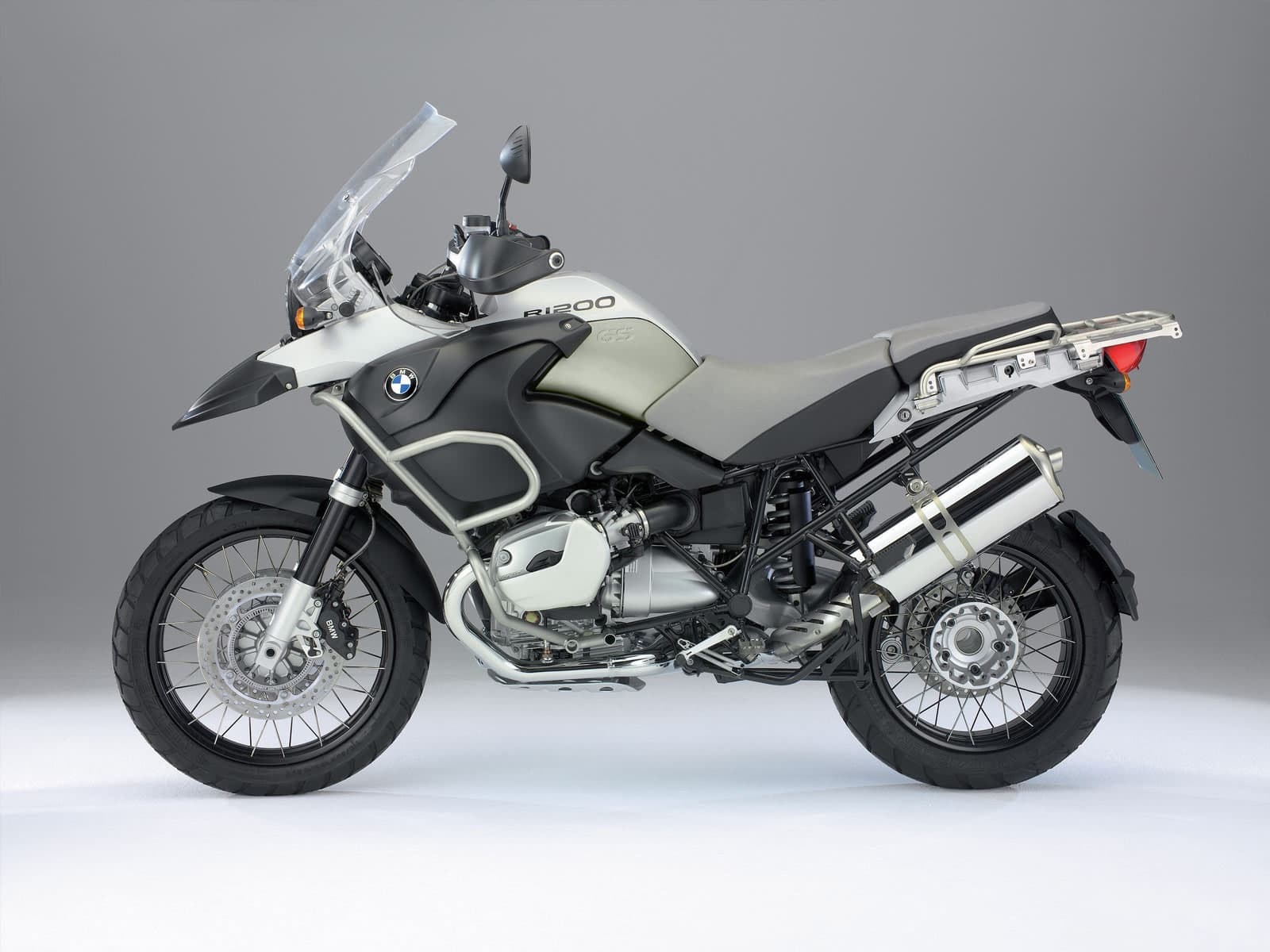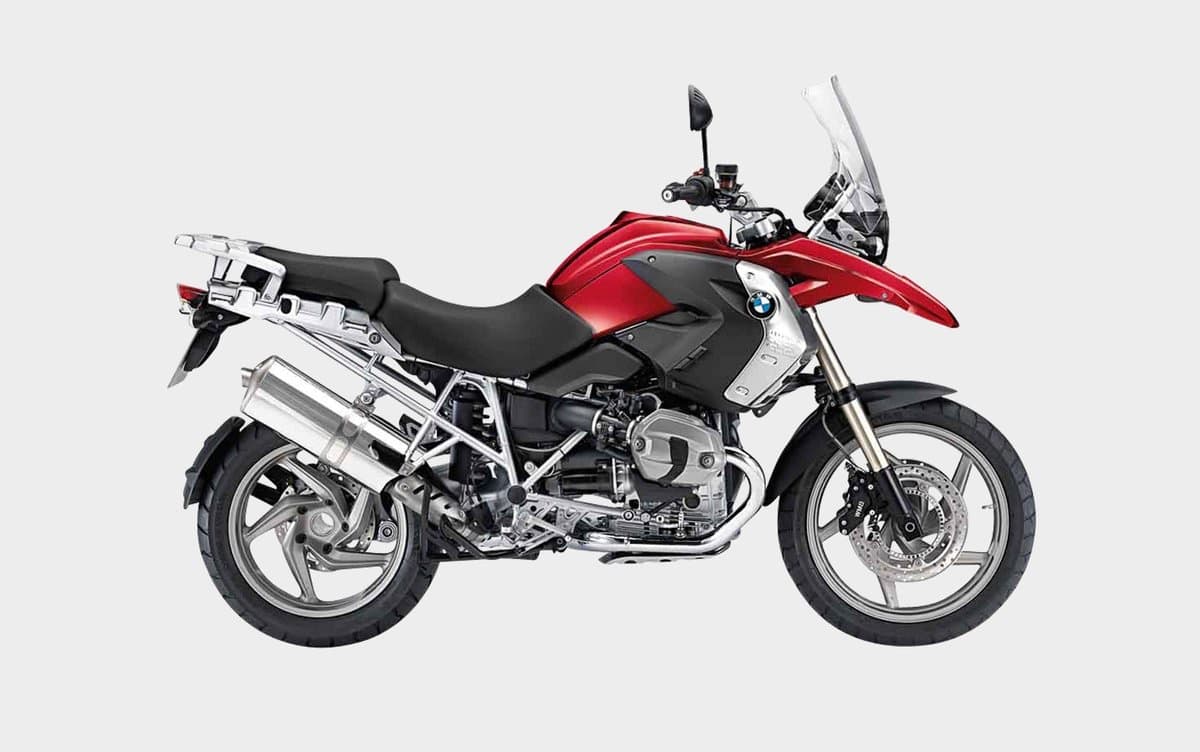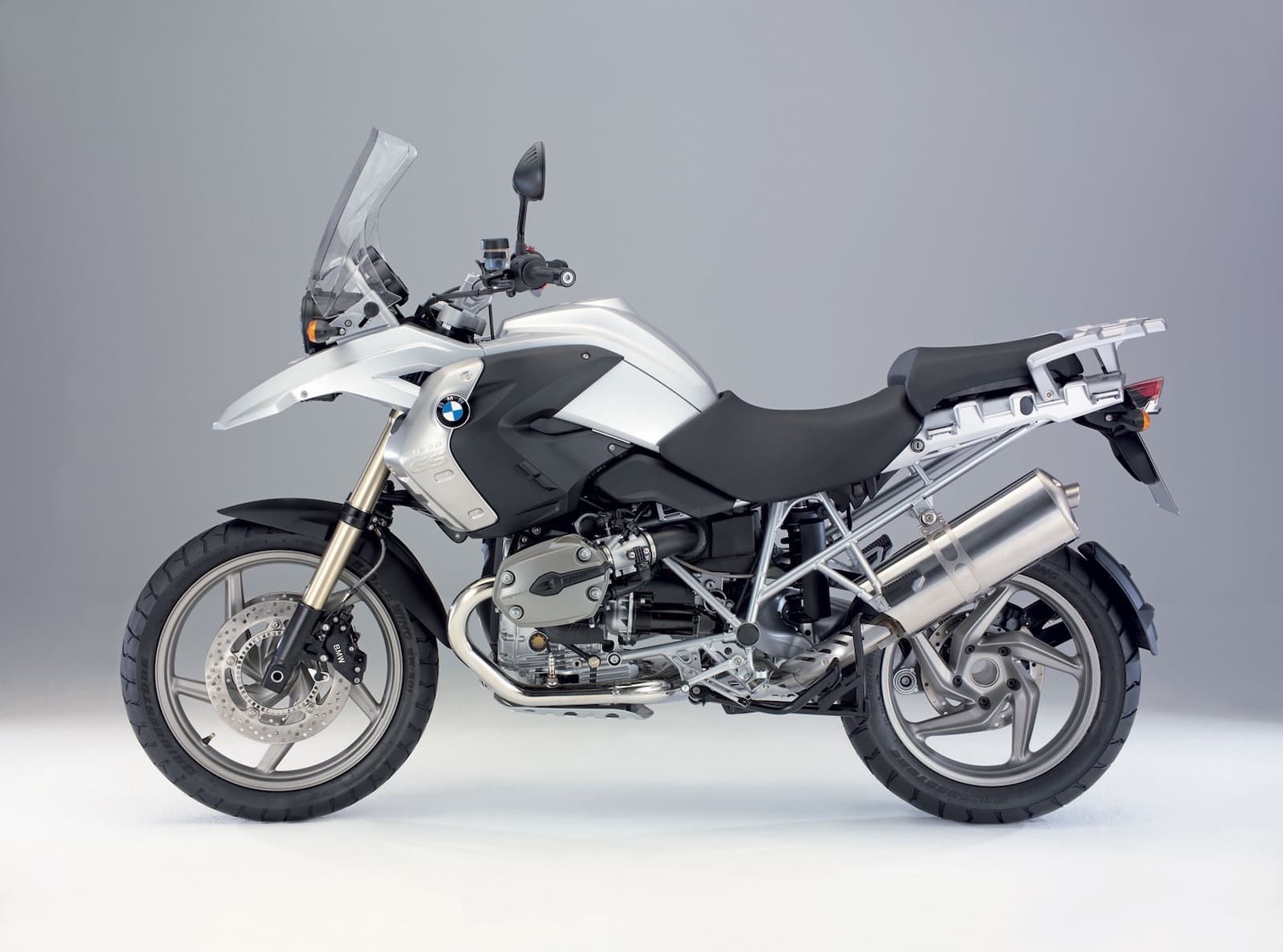BMW R 1200 GS “Hexhead” (2004-2009) Maintenance Schedule and Service Intervals
This is the maintenance schedule and service intervals for the very first generation of BMW R 1200 GS, released in 2004 and made up to the 2009 model year, replacing the outgoing air-cooled BMW R 1150 GS.
This page also includes the maintenance schedule for the BMW R 1200 GS Adventure, made from 2006 onward (replacing the R 1150 GSA which had overlapped a little with the R 1200 GS).
The BMW R 1200 GS is a now iconic motorcycle, continuing the GS legacy of adventure motorcycles. The Hexhead generation is built around an air/oil-cooled 1170cc boxer twin that makes around 100hp, putting power down through a six-speed transmission and a shaft drive.
From 2010 to 2013, BMW used a new twin-cam “camhead” motor in the 2010-2013 BMW R 1200 GS and GSA models.
Here are all the big BMW GS models for which we have maintenance schedules
- BMW R 1100 GS (1994-1998)
- BMW R 1150 GS / Adventure (1999-2005)
- BMW R 1200 GS / Adventure, Hexhead (2004-2009)
- BMW R 1200 GS / Adventure, Camhead (2010-2014)
- BMW R 1200 GS / Adventure, Liquid-cooled (a.k.a. Wethead) (2013-2018)
- BMW R 1250 GS / Adventure, “ShiftCam” (2019+)
- BMW R 1300 GS (2024+)
Maintenance for this generation Hexhead BMW is quite similar to that for other Hexhead of the same era, e.g. the BMW R 1200 R.
This site has links for things like oil and spark plugs from which we earn a commission (which unfortunately nobody can save, not even us). If you appreciate this work, then please use those links. Thanks!
Service intervals for the BMW R 1200 GS (Hexhead)
The first-gen 2004-2009 air/oil-cooled Hexhead BMW R 1200 GS has 6000 mile / 10000 km service intervals, at which BMW recommends you change the engine oil, change the oil filter, check and adjust valve clearances, and do a series of other checks on the motorcycle (including checking for leaks and lubrication needs).
BMW also recommends changing the oil every year, even if you have not used your motorcycle in that time (i.e. you didn’t reach the recommended service distance).
Every two services, change the air filter. You also should change brake and clutch fluid every 2 years, regardless of distance travelled.
Then every four services, change the spark plugs and gearbox oil.
The gearbox oil has a longer service interval than its predecessor, the R 1150 GS, because of BMW’s redesign of the gearbox. The gear shafts run on anti-friction ball bearings, with the gears themselves in low friction needle bearings. The ball bearings come in clean bearing mounts sealed at the surface. This sealing prevents fine particles to enter, allows even longer maintenance intervals for the gearbox.
The valves in the 2004-2009 BMW R 1200 GS are driven by pushrods and rocker arms from camshafts underneath the valves. Adjustments are done by screw and locknut.
The maintenance schedule also has a few other long-term items, like changing the alternator belt.
Maintenance schedule for the 2004-2009 BMW R 1200 GS
Below is the maintenance schedule for the BMW R 1200 GS Hexhead made between 2004 and 2009.
This maintenance schedule is presented in a different format in the manuals and various references. It’s consolidated into one table below for your convenience. The “Dealer” items are at the bottom because not everyone has a BMW diagnostic system.
Notes on the schedule
- Some of the items have to be done every 10000 km (e.g. change the oil, or checking the valve clearances), and some less frequently (e.g. change gearbox oil or alternator belt)
- The original schedule is in KM in most markets; miles are added for convenience for US and UK riders.
- The maintenance schedule for many items follows a “per x years” or “x distance” schedule. Follow whichever comes first (e.g. if you have the bike for a year and don’t put 10000 km on it, change the oil anyway)
| miles x 1000 | 6 | 12 | 18 | 24 | 30 | 36 | |
|---|---|---|---|---|---|---|---|
| km x 1000 | 10 | 20 | 30 | 40 | 50 | 60 | Every |
| Change engine oil change and oil filter | X | X | X | X | X | X | Year |
| Change gearbox oil | X | 2 years | |||||
| Tighten cylinder head fasteners | |||||||
| Adjust valve clearances | X | X | X | X | X | X | |
| Replace spark plugs (4 x DCPR8EKC) | X | ||||||
| Replace air filter element | X | X | X | ||||
| Replace generator belt* | X | 6 years | |||||
| Visually inspect hydraulic clutch system | X | X | X | X | X | X | |
| Check front and rear brake discs for wear | X | X | X | X | X | X | |
| Check front and rear brake pads for wear | X | X | X | X | X | X | |
| Check brake fluid level, front and rear | X | X | X | X | X | X | |
| Change brake fluid (including in wheel ABS system), front and rear | 2 years | ||||||
| Change brake fluid in ABS control circuit | 4 years | ||||||
| Check freedom of movement of throttle cable and check for kinks and chafing | X | X | X | X | X | X | year |
| Check tyre pressures and tread depth | X | X | X | X | X | X | year |
| (Spoke wheels) Check spoke tension, adjust if necessary | X | X | X | X | X | X | |
| Check ease of movement of side and center stand | X | X | X | X | X | X | |
| Check lights and signal equipment | X | X | X | X | X | X | year |
| Function test, engine start suppression | X | X | X | X | X | X | year |
| Check synchronisation | X | X | X | X | X | X | |
| Check battery charge state | X | X | X | year | |||
| Test ride as final inspection and function check | X | X | X | X | X | X | year |
| Dealer checks: | |||||||
| Read fault memory with BMW Motorrad diagnostic system | X | X | X | X | X | X | |
| Perform bleed (brake) test with the BMW Motorrad diagnostic system | X | X | X | X | X | X | |
| Read error memory with (BMW Motorrad) diagnostic system | X | X | X | X | X | X | |
| Confirm BMW Service in on-board documentation | X | X | X | X | X | X | year |
* Manuals for later models of the R 1200 GS recommend changing the alternator belt every six years or 40,000 km (shorter than 60,000), so do as you think is wise.
About the 2004-2009 “Hexhead” BMW R 1200 GS

The BMW R 1200 GS is an iconic member of BMW’s top-of-the-line adventure motorcycle, previously the BMW R 1150 GS and these days the BMW R 1250 GS.
The original R 1200 GS caused quite a stir when it arrived in 2004 because it was more powerful, more refined, and a LOT lighter (30kg or 66 lb) than the outgoing BMW R 1150 GS, which already was very well loved (and still is).
In fact, the R 1200 GS became one of BMW’s most popular motorcycles, even in Europe which has no tundra to cross. BMW didn’t invent the “adventure touring” motorcycle category but they did become synonymous with it, thanks in large part to the R 1200 GS.
The early Hexhead BMW R 1200 GS had a bit of tech (ABS as an option, but a frequently chosen one, and also heated grips), but lacked a lot of what came with later models — no traction control, no ride by wire, no IMU, no Automatic Stability Control. So it’s still somewhat of a raw experience to ride.
The cockpit of the R 1200 GS in this period reflects the tech of the time. It has a couple of gauges for the speed and rpms and a digital display panel for other information.
The engine of the R 1200 GS makes 73 kW (98 hp) in the first years, and then 76 kW (105 hp) from 2007-2009. They feel much the same (although more power is always good), especially as your average GS rider will probably have weighed the bike down with luggage and accessories, dulling the impact of a few hp here and there. There’s torque everywhere in the motor. It’s not “revvy” but it’s also not dull, and can pull in most gears in the middle of the torque band. Some describe it as easy to wheelie, but it won’t loft its wheel into the air without you trying.
A nice feature of the Hexhead engine in the R 1200 GS is the counterbalancing shaft. This helps keep the bike a lot more vibration-free than the earlier R 1150 GS models. It still vibrates a lot, of course… it’s a boxer… and has that traditional kick over to the left every time you grab the throttle a little at a standstill.
Shifting on the R 1200 GS is very pleasant. Just like on any of BMW’s big bikes, really — you never have to “kick” it into gear, it just shifts.
One fly in the ointment of the R 1200 GS is the servo brake unit on the 2004-2006 models. This is often called “whizzy brakes” or “servo-assisted brakes”. You can feel the unit clamping down when you pull in the brake lever, helping you out. But the drawback to this system is that when it fails, you’re left with very little braking, which can be really dangerous. And repairing it costs thousands of dollars.
For this reason alone, among the hexheads, people prefer models that either never came with ABS, or which are 2007-2009 models. (On which ABS can fail — it always can — but won’t leave you stranded.)
Manual for the BMW R 1200 GS

The above maintenance schedule was assembled from PDFs of checklists from dealers. You can get some of those from this website.
You can also download the manual for the BMW R 1200 GS from BMW’s website here.
























👏👏